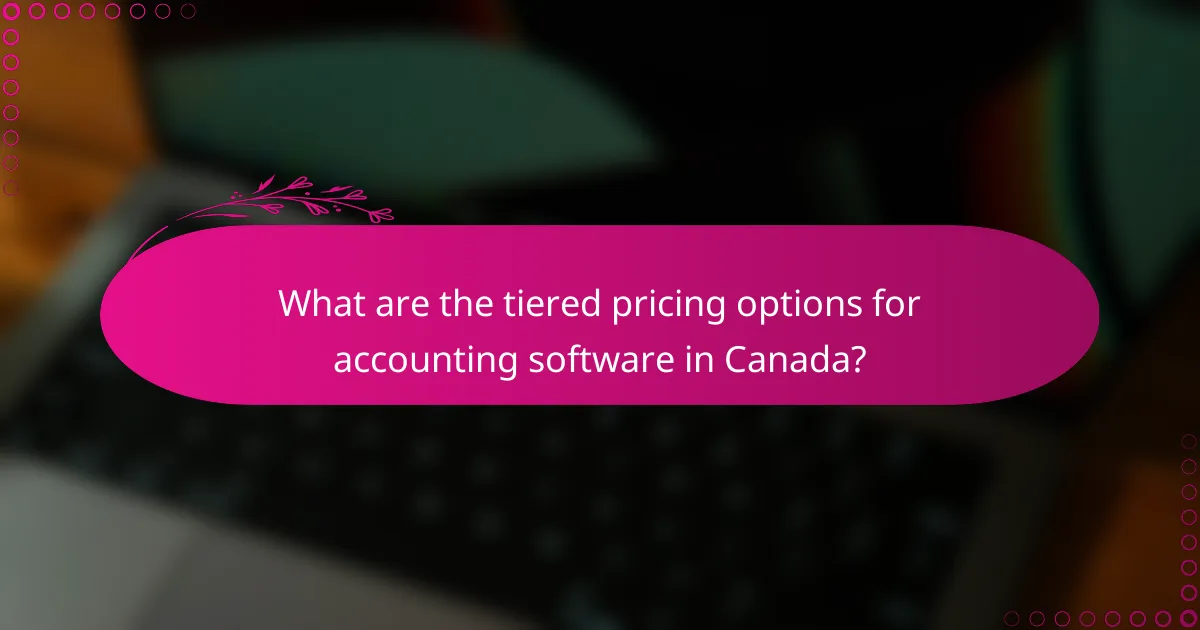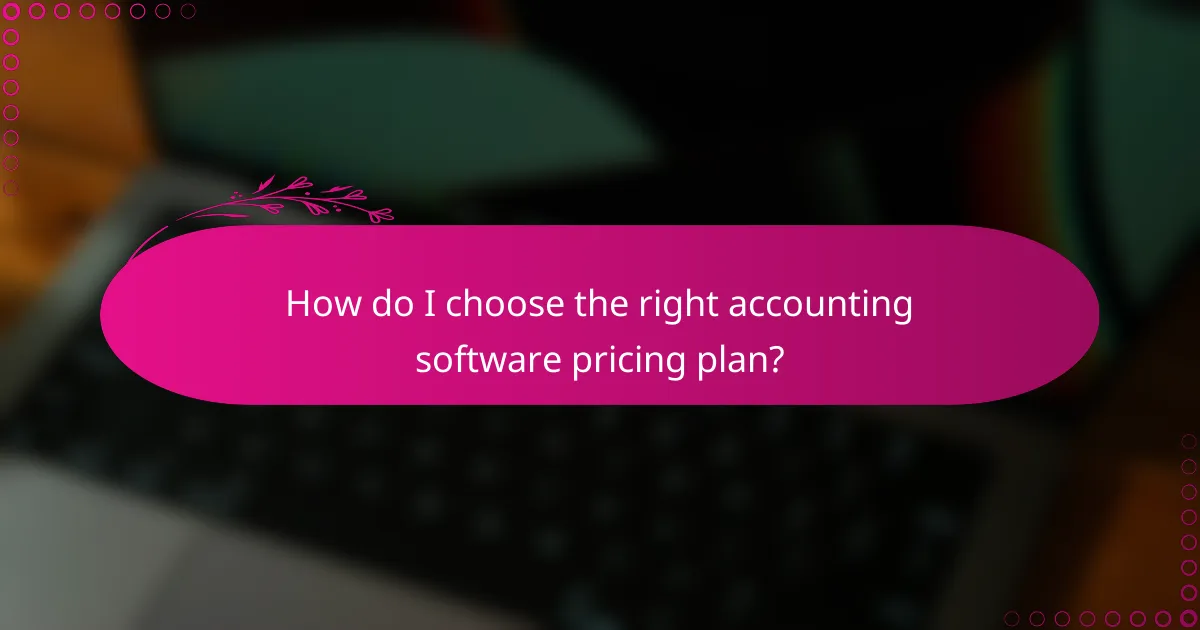Accounting software often utilizes a tiered pricing model, allowing businesses to choose from various subscription levels that cater to different needs and sizes. This model typically includes additional user costs for those exceeding a set limit, which can escalate as a company grows. Furthermore, upgrade fees can vary widely, impacting the overall cost depending on the features and user limits of higher-tier plans.

What are the tiered pricing options for accounting software in Canada?
In Canada, tiered pricing for accounting software typically involves multiple subscription levels, each offering varying features and user limits. This structure allows businesses to select a plan that best fits their size and needs, often starting with basic functionality and scaling up to advanced features as required.
QuickBooks Online pricing tiers
QuickBooks Online offers several pricing tiers, including Simple Start, Essentials, Plus, and Advanced. The Simple Start plan is designed for solo entrepreneurs and starts at a low monthly fee, while the Essentials and Plus plans cater to small businesses with additional user access and features like bill management and inventory tracking.
Each tier allows for a different number of users, with the Essentials plan supporting up to three users and the Plus plan accommodating up to five. Upgrading to the Advanced plan provides even more features and can support larger teams, but at a higher monthly cost.
Xero subscription plans
Xero provides three main subscription plans: Early, Growing, and Established. The Early plan is suitable for freelancers or small businesses with a limited number of invoices and bills, while the Growing plan allows for more transactions and additional user access.
The Established plan is ideal for larger businesses needing advanced features like project tracking and multi-currency support. Each plan has a fixed monthly fee, and businesses can easily upgrade as they grow, ensuring they only pay for what they need.
FreshBooks pricing structure
FreshBooks has a tiered pricing structure that includes Lite, Plus, Premium, and Select plans. The Lite plan is perfect for freelancers and allows for a limited number of clients, while the Plus and Premium plans offer more features and support for additional clients.
FreshBooks also charges for extra users on the Plus and Premium plans, which can be a consideration for growing teams. Upgrading to the Select plan provides custom pricing and features tailored to larger businesses, making it a flexible option for various needs.

What additional user costs should I expect?
When using accounting software, additional user costs can vary significantly based on the platform and pricing tier. Most providers charge extra fees for additional users beyond a certain limit, and these costs can add up quickly, especially for growing businesses.
Extra user fees for QuickBooks Online
QuickBooks Online typically allows one user per subscription, with additional users costing around $25 to $50 each per month, depending on the plan. Businesses should consider the total number of users they need when selecting a plan to avoid unexpected costs.
It’s also worth noting that QuickBooks offers discounts for annual subscriptions, which can help mitigate the overall expense if you plan to use the software long-term.
Xero additional user charges
Xero has a straightforward pricing structure where the base plan includes one user, and additional users can be added for about $10 each per month. This pricing model is beneficial for small to medium-sized businesses that may need to scale their user base over time.
Keep in mind that Xero also offers a free trial, allowing potential users to assess their needs and costs before committing to a subscription.
FreshBooks user cost breakdown
FreshBooks includes one user in its basic plan, with additional users typically costing around $10 per user per month. This makes it a flexible option for freelancers and small teams looking to manage their accounting without incurring high costs.
FreshBooks also provides tiered pricing based on the number of billable clients, which can influence overall costs. Businesses should evaluate their client base to choose the most cost-effective plan.

What are the upgrade fees for accounting software?
Upgrade fees for accounting software vary significantly based on the provider and the specific plan chosen. Generally, these fees can range from nominal monthly increases to more substantial costs, depending on the features and user limits associated with higher-tier plans.
QuickBooks Online upgrade costs
QuickBooks Online offers several tiers, each with its own pricing structure. Upgrading to a higher plan typically incurs an additional monthly fee, which can range from around $10 to $50, depending on the features included. Users should consider their current usage and future needs before upgrading, as some plans may include features like advanced reporting or inventory management that could be beneficial.
Additionally, QuickBooks often runs promotions that can reduce the cost of upgrades for the first few months, so it’s wise to check for any available discounts before making a decision.
Xero plan upgrade fees
Xero has three main pricing tiers, with upgrade fees reflecting the additional features offered at each level. Upgrading can cost between $10 to $30 more per month, depending on the plan chosen. Users should evaluate their business requirements, such as the number of invoices or bills processed monthly, to determine if an upgrade is justified.
Xero also provides a 30-day free trial for new users, allowing businesses to test higher-tier plans before committing to an upgrade.
FreshBooks upgrade pricing
FreshBooks has a tiered pricing model with upgrade fees that typically range from $6 to $20 more per month. The cost varies based on the number of clients and features included, such as time tracking or project management tools. Businesses should assess their client load and specific needs to choose the most cost-effective plan.
FreshBooks frequently offers discounts for annual subscriptions, which can make upgrading more affordable over the long term. Always review the features included in each tier to ensure the upgrade aligns with your business goals.

How do I choose the right accounting software pricing plan?
Choosing the right accounting software pricing plan involves evaluating your business needs against the features offered at various price points. Consider factors like the number of users, specific functionalities, and potential upgrade costs to ensure the plan aligns with your financial and operational goals.
Factors to consider for pricing selection
When selecting a pricing plan, first assess the size of your business and the number of users who will need access to the software. Many providers charge extra for additional users, so factor these costs into your budget. Additionally, consider whether you need features like invoicing, payroll, or tax preparation, as these can significantly impact the price.
Another important factor is the potential for future growth. If you anticipate expanding your team or requiring more advanced features, choose a plan that allows for easy upgrades without excessive fees. Look for software that offers tiered pricing, which can provide flexibility as your needs evolve.
Comparative analysis of features
Conduct a comparative analysis of the features included in each pricing tier. For example, basic plans may only offer essential functions like expense tracking and reporting, while higher tiers might include advanced analytics, multi-currency support, or integrations with other business tools. Create a checklist of must-have features to help you evaluate each option effectively.
Additionally, consider the total cost of ownership, which includes not only the monthly or annual subscription fees but also any upgrade fees and costs for additional users. Some software may appear cheaper initially but can become costly as you add features or users. Comparing these aspects can help you make a more informed decision.

What are the common pricing models for SaaS accounting tools?
SaaS accounting tools typically employ tiered pricing models, where costs vary based on features and user count. These models help businesses choose plans that align with their size and needs, often including additional fees for extra users or upgrades.
Monthly vs annual billing options
Most SaaS accounting software offers both monthly and annual billing options. Monthly plans provide flexibility, allowing businesses to adjust their subscriptions based on changing needs, while annual plans often come with a discount, making them more cost-effective in the long run.
When considering which option to choose, evaluate your company’s stability and growth projections. If you anticipate needing the software long-term, an annual plan could save money. Conversely, if your needs are uncertain, monthly billing may be preferable.
Freemium models in accounting software
Freemium models allow users to access basic features of accounting software at no cost, with the option to upgrade for advanced functionalities. This approach can be beneficial for startups or small businesses that want to test the software before committing financially.
However, be aware that freemium versions often come with limitations, such as restricted user access or fewer reporting options. Assess whether the free features meet your needs or if the costs of upgrading are justified based on your business requirements.

What emerging trends are shaping accounting software pricing?
Emerging trends in accounting software pricing are increasingly influenced by technology advancements, user preferences, and integration capabilities. Businesses are looking for flexible pricing models that can adapt to their specific needs while providing value through additional features and integrations.
Impact of AI on pricing structures
Artificial Intelligence (AI) is reshaping pricing structures by enabling more personalized and dynamic pricing models. Software providers can analyze user behavior and adjust pricing based on usage patterns, which can lead to more tailored subscription plans.
For example, some platforms may offer lower rates for businesses that utilize AI features extensively, while charging more for those who do not. This creates a performance-based pricing model that aligns costs with value received.
Subscription flexibility and user demand
Subscription flexibility is becoming a key factor in accounting software pricing, as businesses demand more control over their plans. Many providers now offer tiered pricing that allows companies to scale their subscriptions based on the number of users or features needed.
For instance, a small business might start with a basic plan for a few users and upgrade as their team grows. This flexibility helps businesses manage costs effectively while ensuring they have access to necessary tools.
Integration costs with other financial tools
Integration costs are a significant consideration when evaluating accounting software pricing. Many businesses require their accounting software to work seamlessly with other financial tools, such as payroll systems or CRM platforms.
These integrations can sometimes incur additional fees, which can vary widely depending on the complexity of the integration. It’s essential to factor in these costs when budgeting for accounting software, as they can significantly impact the overall expense.
